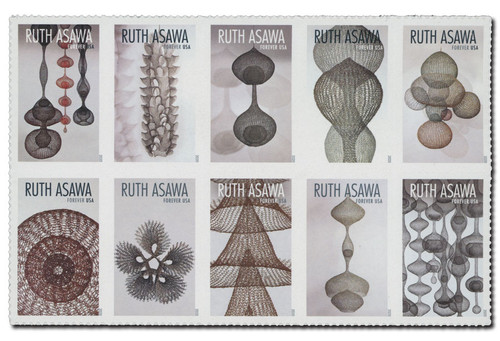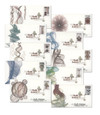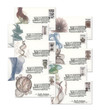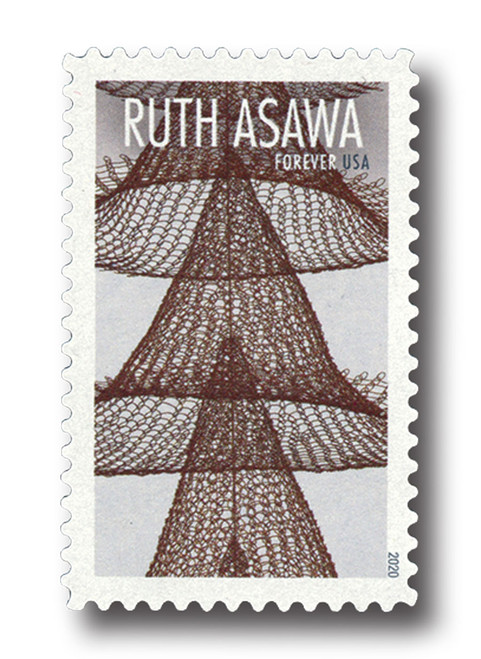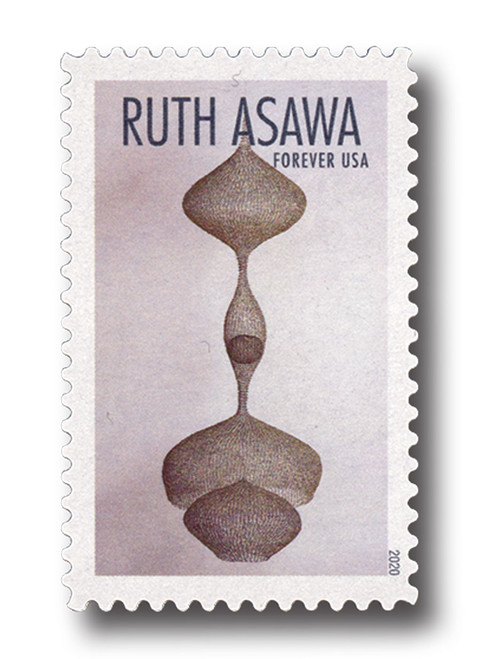
# 5504-13 - 2020 First-Class Forever Stamps - Ruth Asawa
US #5504-13
2020 Ruth Asawa
- 10 stamps picturing different wire sculptures by Japanese- American artist Ruth Asawa
Stamp Category: Commemorative
Value: 55¢ First Class Mail Rate (Forever)
First Day of Issue: August 13, 2020
First Day City: San Francisco, California
Quantity Issued: 18,000,000
Printed by: Banknote Corporation of America
Printing Method: Offset
Format: Panes of 20
Tagging: Phosphor, block tag
Why the stamps were issued: To commemorate Japanese-American artist Ruth Asawa and her contributions to the art and education worlds.
About the stamp designs: Each stamp design pictures a photograph by Dan Bradica and Laurence Cuneo of a different Ruth Asawa wire sculpture.
First Day City: The First Day of Issue Ceremony was held virtually due to the Covid-19 pandemic. The First Day of Issue postmark was from San Francisco, California, home to the Ruth Asawa San Francisco School of the Arts.
History the stamp represents: Despite facing adversity from a young age, Ruth Asawa (1926-2013) was an accomplished artist with several public works. She was also the driving force behind art education reforms in California.
Born to Japanese immigrants, Asawa’s life was turned upside-down following the Japanese bombing of Pearl Harbor. Her family was sent to internment camps and she didn’t see her father for six years. While Asawa was permitted to leave the camp to attend college, she was unable to complete her student teaching because of anti-Japanese sentiment.
Asawa went on to attend Black Mountain College, where she closely worked with professional artists. It was here that she first began fashioning ornate sculptures out of wire. These sculptures came to be some of her most recognizable work. Inspired by nature, they played with notions of space. You could see the inside and outside at the same time, while the shadows they cast added another dimension. Asawa was also known for her public sculptures throughout San Francisco. She created many reliefs and fountains – so many that she was known as the “Fountain Lady.”
Asawa’s passion project was arts education. She started an arts workshop, which brought professional artists to schools. She also started SCRAP, which offers free or low-cost art supplies to schools. In 1982, she helped open a school of the arts, which was later renamed in her honor.
Asawa’s work touched countless lives. In 2020, her art appeared on a set of US stamps, ensuring her creativity will inspire countless more.
US #5504-13
2020 Ruth Asawa
- 10 stamps picturing different wire sculptures by Japanese- American artist Ruth Asawa
Stamp Category: Commemorative
Value: 55¢ First Class Mail Rate (Forever)
First Day of Issue: August 13, 2020
First Day City: San Francisco, California
Quantity Issued: 18,000,000
Printed by: Banknote Corporation of America
Printing Method: Offset
Format: Panes of 20
Tagging: Phosphor, block tag
Why the stamps were issued: To commemorate Japanese-American artist Ruth Asawa and her contributions to the art and education worlds.
About the stamp designs: Each stamp design pictures a photograph by Dan Bradica and Laurence Cuneo of a different Ruth Asawa wire sculpture.
First Day City: The First Day of Issue Ceremony was held virtually due to the Covid-19 pandemic. The First Day of Issue postmark was from San Francisco, California, home to the Ruth Asawa San Francisco School of the Arts.
History the stamp represents: Despite facing adversity from a young age, Ruth Asawa (1926-2013) was an accomplished artist with several public works. She was also the driving force behind art education reforms in California.
Born to Japanese immigrants, Asawa’s life was turned upside-down following the Japanese bombing of Pearl Harbor. Her family was sent to internment camps and she didn’t see her father for six years. While Asawa was permitted to leave the camp to attend college, she was unable to complete her student teaching because of anti-Japanese sentiment.
Asawa went on to attend Black Mountain College, where she closely worked with professional artists. It was here that she first began fashioning ornate sculptures out of wire. These sculptures came to be some of her most recognizable work. Inspired by nature, they played with notions of space. You could see the inside and outside at the same time, while the shadows they cast added another dimension. Asawa was also known for her public sculptures throughout San Francisco. She created many reliefs and fountains – so many that she was known as the “Fountain Lady.”
Asawa’s passion project was arts education. She started an arts workshop, which brought professional artists to schools. She also started SCRAP, which offers free or low-cost art supplies to schools. In 1982, she helped open a school of the arts, which was later renamed in her honor.
Asawa’s work touched countless lives. In 2020, her art appeared on a set of US stamps, ensuring her creativity will inspire countless more.

